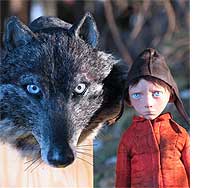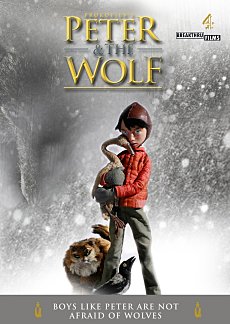Interview with Hugh Welchman of “Peter and the Wolf”
Posted on March 23, 2008 at 2:00 pm
Peter and the Wolf,” this year’s Oscar-winner for best short animated film will be shown on PBS this Wednesday from 8-9 Eastern Time. It is a brilliantly imaginative film and well worth setting aside some family time to watch it together.
“Peter and the Wolf” was originally written by Sergei Prokofiev in 1936 as a way to introduce children to the instruments of the orchestra. A brief narration tells the story of the little boy who goes into the forest with his pet duck and cat. They meet up with a little bird and have an encounter with a scary wolf. Each character in the story is represented by a different instrument.
Bird: flute
Duck: oboe
Cat: clarinet
Grandfather: bassoon
Wolf: French horns
Hunters: percussion
Peter: strings
There have been many film versions of the story. Perhaps the most famous is a Disney animated cartoon made in 1946. This latest version, produced by Hugh Welchman of Breakthru Films, dispenses with the narration, which only takes up three minutes of the half-hour-long musical composition, but creates a complex and involving story with a contemporary setting that remains very true to the themes of the original. I spoke to Welchman about the challenges of creating Peter’s world for the painstaking stop-motion animation to create the film.
How big was the set?
 “We were working at a one in five ratio. That’s the normal scale for stop-motion animation. The set was truly enormous. The forest had 1700 trees, each 6 feet high. The set was 80 feet long; it was like going into Wonderland. We also did all the close-ups at 1 in 3 . The grandfather puppet was 3 1/2 feet high. With that size, you get so much more detail. The grandfather’s hands were incredibly detailed which gave it a real different quality and makes it much more real.
“We were working at a one in five ratio. That’s the normal scale for stop-motion animation. The set was truly enormous. The forest had 1700 trees, each 6 feet high. The set was 80 feet long; it was like going into Wonderland. We also did all the close-ups at 1 in 3 . The grandfather puppet was 3 1/2 feet high. With that size, you get so much more detail. The grandfather’s hands were incredibly detailed which gave it a real different quality and makes it much more real.
The set was built in Poland and they worked amazingly quickly to build it. That was one of the fastest part of the process; making the models took much, much longer. We wanted it set in modern Russia and so we went there to take photographs. On a playground somewhere they found Peter. And they were arrested by the KGB for taking photographs of a power station! The Russian police didn’t really know what to do with these two women. They thought they were eco-terrorists. So, they wiped their photos.
But the Russians are very knowledgeable about film, especially animation.
Yes, they’ve got a heritage with stop-motion.
What led you to this project?
The music director approached me to ask whether I had ever thought about doing a film to live music. We went through a list new, old, famous, not famous. I was instantly interested in this because I had literally listened to it thousands of times. It struck a chord in my brain. I thought it must have been done thousands of times and was really surprised by the versions that were out there. They had not really grasped the potential. The story is only three minutes long and the music is 30 minutes. There is not enough story to go with the music so we had to write another 27 minutes of story. Our version has a range of emotion, very funny, very moving, very scary in places. An important thing to do in our film version was cover all those emotions. We also found that people who knew it well were 30 and over and those who were younger did not know it well. Younger grew up with videos. We wanted to make a version that would work for adults as well, adults introducing children to it rather than the other way around. 
What changes did you made to the story?
In the original 1936 Prokofiev version, he writes that Peter stops the hunters from hurting the wolf and took the wolf to the zoo. Then and now that is a very radical idea in Russia. They’re out shooting wolves still. Nowadays not such a radical idea, more and more what you have around the globe, starting in America, is conservationists reintroduce them to the wild. Let the wolf go back into the big forest again. That is what Peter would do if he was doing it now. And Prokofiev’s family was cool with it, giving it a more environmentally conscious feeling.
I have to ask — what does it feel like to win an Oscar?
Immense, really special. We received 23 or 24 international prizes before that but I wasn’t prepared for how it made me feel, welling up from my toes. I had a smile I could not get rid of for days.

I remember listening to Peter and the Wolf in elementary school. It seemed a bit unusual to me then! Cindi
I’ve looked everywhere for this movie to show to my children. I’m looking forward to watching it tonight.THANK YOU HUGH…I’m sure we will enjoy it..